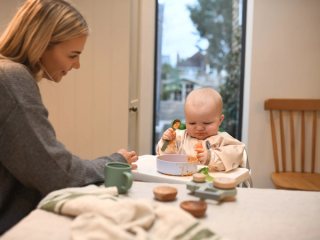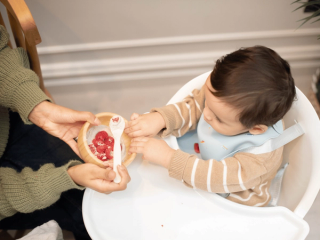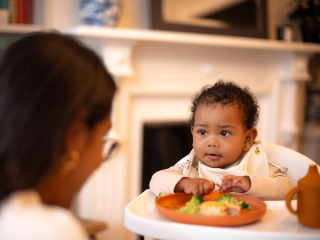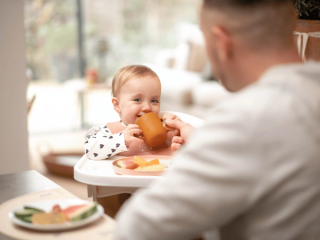
- Home
- Advice Hub
- Baby
- Weaning
- A Guide To Introducing Allergens During Weaning
Introducing allergens during weaning
Read our expert guide to learn more about the types of allergens and how to incorporate these into your weaning schedules.
Is my baby at risk of food allergy?
If I have an allergy, should I give my baby that food?
How many allergens are there?
How should I introduce allergens to my baby?
Tips on introducing allergens
Which allergen should I introduce first?
What are the signs of a food allergy?
What should I do if my child reacts to the introduction of the allergen?
Introducing allergen rich foods is a topic that can cause huge amounts of fear and confusion for parents. With scary stories circulating on social media and in newspapers it can feel like it’s best to avoid giving these foods all together. But, that’s definitely not the best way to approach it as we know that delaying giving these foods increases the chance of a reaction.
In the UK it is estimated that 41 million people are living with Allergy. With around 40% of children being affected by different types of allergies, also known as atopy, including food allergy, non-food allergy asthma, eczema and hay fever. Food allergy affects between 5 and 8% of children (Allergy UK). More severe reactions are much rarer and affect only 1-2 in every thousand children.
Is my baby at risk of food allergy?
Some babies are at a higher risk of developing food allergies. This group includes babies with eczema, especially moderate to severe cases requiring regular steroid creams before six months of age. It also includes those with a pre-existing food allergy, such as a cow's milk protein allergy (BSACI).
Even if your baby is at higher risk of allergy, try to remember that it is a risk, not a clear cut yes or no situation. The advice is to still offer allergens and monitor for any signs or symptoms of a reaction.
If I have an allergy, should I give my baby that food?
Yes, even if you have an allergy yourself you should still offer that food to your baby. If you have a food allergy yourself, you may pass on one of the other atopy conditions to your baby and probably not your exact allergy. As an example, if you have a peanut allergy, your baby may have hay fever or a non-food allergy.
How many allergens are there?
The reality is that unfortunately you can be allergic to any food, but, the vast majority of people worldwide are allergic to one of 14 foods which are :
- Eggs
- Milk
- Fish
- Cereals containing gluten (including wheat, barley & rye)
- Soybean
- Sesame
- Shellfish (such as prawns, crab and lobster)
- Molluscs (such as mussels and oysters)
- Mustard
- Peanuts
- Tree nuts (such as cashews, pecans, pistachios, macadamia, almonds, hazelnuts, walnuts and Brazil nuts)
- Celery
- Lupin (a type of legume in the same family as peanuts)
- Sulphites (a preservative added to foods).
In the UK, when it comes to weaning, the main allergens to focus on are: milk, egg, peanuts, tree nuts, fish and shellfish, wheat, sesame and soya.
How should I introduce allergens to my baby?
When to introduce allergens
If your baby is at higher risk of allergy, they may benefit from early introduction of solids at 4 months of age to reduce their risk of reacting to foods, especially peanut and egg. Please speak to your health visitor if you are unsure about your baby’s risk and whether you should start weaning early.
If your baby is not at higher risk then you should offer the allergens from six months, making sure that they have all been given before their first birthday.
Introducing the allergens doesn’t need to be complicated, if you stick to these simple pointers you should breeze through them without any issues:
- Offer them one at a time (starting with egg and peanut then moving through in whichever order suits your family).
- Give a small amount, around ¼ to ½ a teaspoon, mixed into a small amount of a food your baby eats regularly - pureed vegetables works well. Gradually build the portion over 3 days and monitor for any reactions.
- Don’t give any other new allergens during the 3 days
Once you have successfully introduced a new allergen, it should be given at least once a week to maintain tolerance going forward.
Tips on introducing allergens
There’s no right or wrong way to offer foods; it will depend on whether you are baby led weaning or spoon feeding as well as the types of food your family eats. To give you a better idea, here are some helpful suggestions to get you started:
Egg: hard boil an egg then mash it and add to some pureed vegetables or offer a mouthful of scrambled egg or omelette.
Nuts: add nut butters or ground nuts to our baby porridge or banana yoghurt breakfast jar.
Milk: If you’re formula feeding, your baby is already consuming milk so you don’t need to worry about this one. If you’re breastfeeding you could give some yoghurt or mix a little milk into your baby’s porridge.
Wheat: give a spoonful of cereal such as Weetabix, a bite of toast or a piece of well cooked pasta.
Sesame: give a small amount of hummus (check it contains tahini which is crushed sesame seeds) or blend some sesame seeds yourself and add some to your baby’s food.
Fish: offer some flakes of fish or blend some fish and mix into mash potato or another food your little one enjoys.
Soya: offer some soya yoghurt or mash some soya beans.
Which allergen should I introduce first?
Once you have given your first couple of weeks of green vegetables you can start to think about introducing allergens into your baby’s meals. It is recommended to start with egg and peanut first and then follow with the other allergens after. It doesn’t matter which order you do these in; just go with what suits you and your baby. Think about which you eat most regularly and offer those first. For example, if you’re a family that eat a lot of hummus you can offer this and see whether your baby tolerates sesame. Or if you are big fish eaters then offer fish to your baby before other options.
What are the signs of a food allergy?
There are two types of allergies to look out for which we go into below. These are both still allergies, but what you do about the different types is very slightly different:
Immediate onset, or IgE mediated allergy involves the immune system and triggers symptoms quickly, usually within around 30 minutes.
- Mild and moderate symptoms are:
- Swelling to the face
- Eyes or mouth
- Hives
- Vomiting/stomach pain
Severe symptoms also known as anaphylaxis are best remembered using the ABC method:
- Airway: Swollen tongue, a hoarse cry or persistent coughing
- Breathing: difficult or noisy breathing, wheezing
- Consciousness: going floppy, pale, unresponsive or unconscious
Delayed onset, or non IgE mediated allergy does not involve the immune system and will happen hours after eating the food.
Symptoms include:
- Stomach pain
- Reflux
- Diarrhoea
- Constipation
- Flaring of eczema
It is worth mentioning that sometimes babies will get a patchy rash or red patches on their face, particularly around the mouth after eating foods such as tomatoes, citrus foods and strawberries. This is not an allergic reaction and is simply because your baby has sensitive skin and these foods can irritate it. If you notice this happening, you can try putting some barrier cream such as Vaseline around the mouth before mealtimes which should minimise the risk of this happening. As your baby gets a little older you are less likely to see this happening.
What should I do if my child reacts to the introduction of the allergen?
If your little one has any of the immediate (IgE) symptoms you should avoid giving the food that caused the symptoms and contact your GP. If it is a delayed reaction (non IgE) wait for symptoms to go down and retest the food a week or two later. If you see symptoms again you should contact your GP.
Hopefully you’ve reached the end of the article feeling empowered with information rather than worried about allergies. If you are feeling a little scared, remember that very few babies have food allergies, and of those it is really quite rare (around 0.1-0.2%) that have severe reactions. The benefit of offering the allergens early means a reaction is less likely and once you have successfully introduced them all your baby can enjoy a really good range of delicious foods with you!












